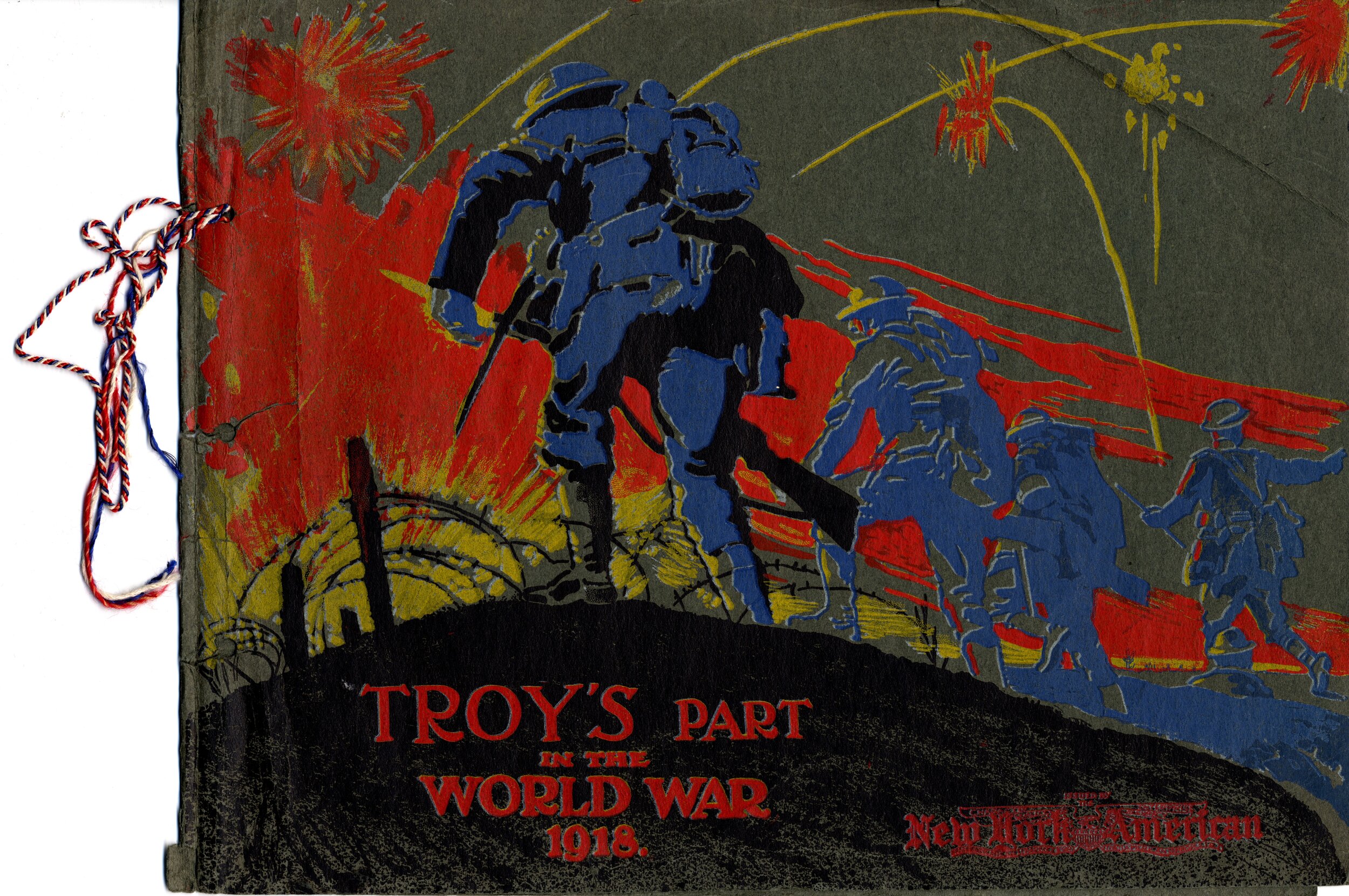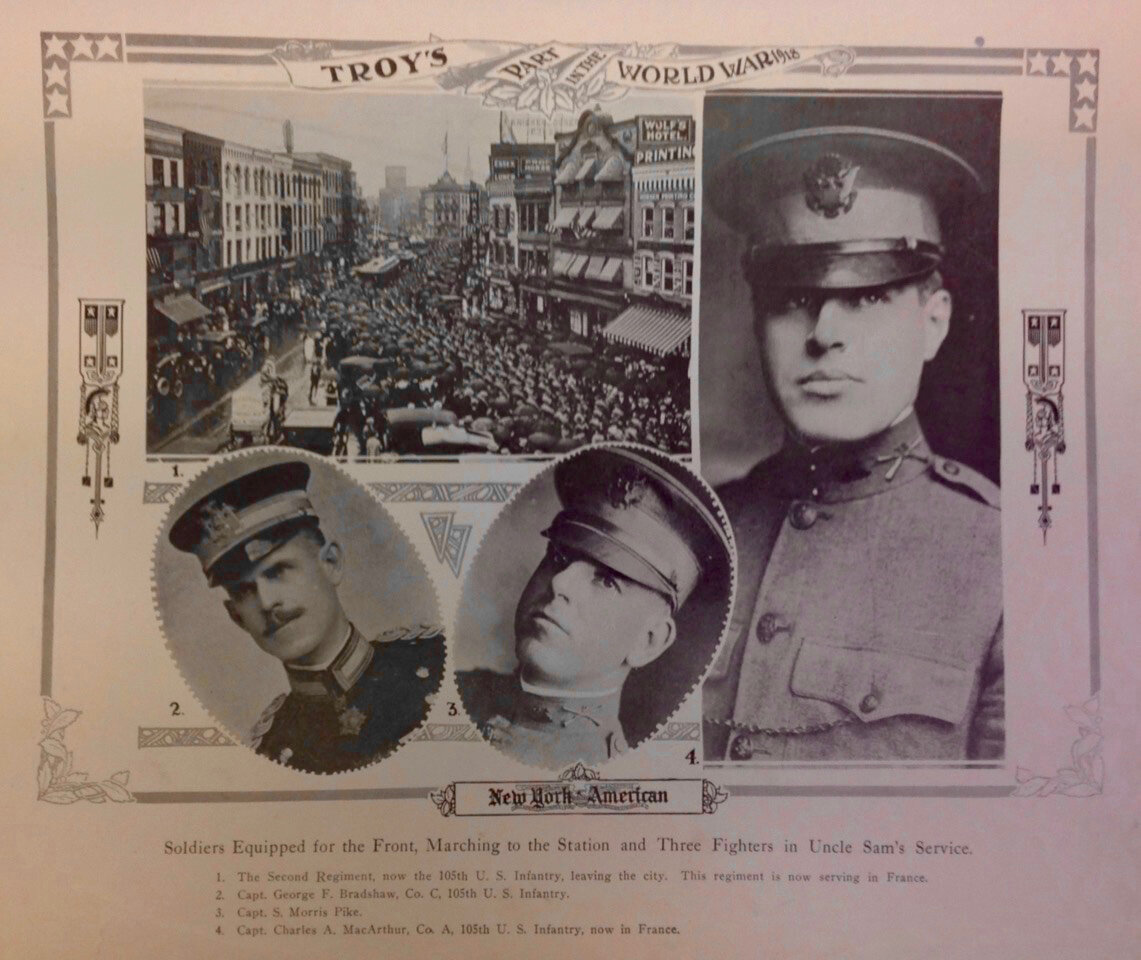The publication Troy's Part in the World War 1918 didn't make note of which parts of Troy the people within it were from, such facts being - then and now - trivial in comparison to the work and sacrifice everyone made.One is nonetheless somewhat curious how many Burghers were involved. World War I began only about half a generation after Lansingburgh was annexed by Troy. In 1917 when the United States joined the war, with the exception of whatever few sixteen year olds might have enlisted, lifelong residents of "Upper Troy" enlisting (and of Schaghticoke south of the Deep Kill) would have been born in the Village or Town of Lansingburgh. At least one prominent Burgher is featured in Troy's Part in the World War 1918, but there could easily be others. There is a great deal of room for anyone to do helpful research in this area, and Lansingburgh's part in other wars post-1901 Troy annexation!

 The 1915 NYS Census and 1920 US Census show the Bradshaw family living at 345 Fourth Avenue in Lansingburgh. Incidentally, many censuses and even some military records can be accessed for free though https://familysearch.org/search and (for New York State residents) through the New York State Library's portal to Ancestry.com at http://www.nysl.nysed.gov/gate/ancestry.htm .
The 1915 NYS Census and 1920 US Census show the Bradshaw family living at 345 Fourth Avenue in Lansingburgh. Incidentally, many censuses and even some military records can be accessed for free though https://familysearch.org/search and (for New York State residents) through the New York State Library's portal to Ancestry.com at http://www.nysl.nysed.gov/gate/ancestry.htm .
Death of Major BradshawMAJ. GEORGE F. BRADSHAW of of the 105th Infantry died at Leonard Hospital, Troy, October 5th, from Bright's disease. Maj. Bradshaw, who was well known throughout the National Guard of the State, had a valorous record of thirty-two years of military service. He had served honorably through the Spanish-American War, the Mexican punitive expedition; and bore a conspicuous record on the battle line in France in 1918. He left Troy for the World War at the head of Co. C. He returned with the rank of Major.He was gassed in battle on the Hindenburg Line, and returned to America with a resultant disability which finally bore him down. The gassing in France contributed directly to his recent ill health, which had persisted over a considerable period, although Bright's disease was the direct cause of death. He was taken to the hospital yesterday morning, and died a few hours afterward. Enlisting in Co. C, Second Infantry, New York National Guard, long before the outbreak of the Spanish-American War, he rose to the rank of Sergeant, and bore that title when the troops embarked from Troy in 1898 for their encampment at Tampa, Fla. Before the Second New York Volunteers were mustered out of service Bradshaw had reached the highest non-commissioned rank, that of regimental sergeant major.As commander of Co. C, Maj. Bradshaw went to the Mexican border in 1916, for the long encampment at Mission, Texas, following the Villa depredations.When the 105th Infantry was mustered into the federalized national guard several years ago, following the World War, Bradshaw became Major of the First Battalion, comprising Co.'s A, C and D of Troy and Co. B of Cohoes; and he employed the ripe experience gained during many years' service, to win added laurels for his battalion and himself. William A. Fletcher succeeded Maj. Bradshaw as Captain of Co. C.Maj. Bradshaw was born at Hoosick Falls, November 10th, 1874. He had been a resident of Lansingburg for many years.His funeral took place Wednesday, October 7th, attended by the units of the First Battalion, 105th Infantry, which he commanded, and full military honors were accorded at
the grave in Oakland [sic] Cemetery.
New York National Guardsman 2(8). November 1925. 11.
https://dmna.ny.gov/historic/research/NY_National_Guardsman/NYNG1925_11.pdf


 The 1915 NYS Census and 1920 US Census show the Bradshaw family living at 345 Fourth Avenue in Lansingburgh. Incidentally, many censuses and even some military records can be accessed for free though https://familysearch.org/search and (for New York State residents) through the New York State Library's portal to Ancestry.com at http://www.nysl.nysed.gov/gate/ancestry.htm .
The 1915 NYS Census and 1920 US Census show the Bradshaw family living at 345 Fourth Avenue in Lansingburgh. Incidentally, many censuses and even some military records can be accessed for free though https://familysearch.org/search and (for New York State residents) through the New York State Library's portal to Ancestry.com at http://www.nysl.nysed.gov/gate/ancestry.htm .